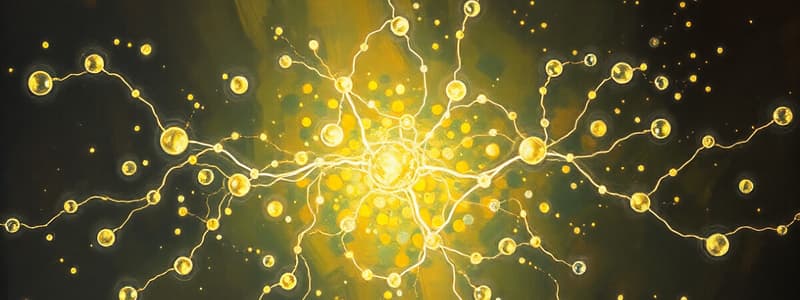Podcast
Questions and Answers
Which of the following bonds is the most polar?
Which of the following bonds is the most polar?
- C-N
- C-C
- C-H
- C-O (correct)
Which of the following molecules is polar?
Which of the following molecules is polar?
- CO2
- NH3 (correct)
- BF3
- CH4
In which of the following molecules do the individual bond dipoles cancel out, resulting in a nonpolar molecule?
In which of the following molecules do the individual bond dipoles cancel out, resulting in a nonpolar molecule?
- CH3Cl
- NH3
- CCl4 (correct)
- H2O
Which of the following factors primarily determines whether a molecule is polar?
Which of the following factors primarily determines whether a molecule is polar?
What is the molecular polarity of a molecule with polar bonds arranged asymmetrically?
What is the molecular polarity of a molecule with polar bonds arranged asymmetrically?
Which of these molecules would you expect to have a dipole moment?
Which of these molecules would you expect to have a dipole moment?
How does a large electronegativity difference between two atoms in a bond affect the bond's polarity?
How does a large electronegativity difference between two atoms in a bond affect the bond's polarity?
Which of the following is true regarding the polarity of a molecule like water (H2O)?
Which of the following is true regarding the polarity of a molecule like water (H2O)?
Which of the following statements concerning polar molecules is correct?
Which of the following statements concerning polar molecules is correct?
What is the effect of increasing the number of polar bonds in a molecule on its overall polarity, assuming the bonds are arranged asymmetrically?
What is the effect of increasing the number of polar bonds in a molecule on its overall polarity, assuming the bonds are arranged asymmetrically?
Which of the following molecules is nonpolar despite having polar bonds?
Which of the following molecules is nonpolar despite having polar bonds?
Which of the following best describes the relationship between bond polarity and molecular polarity?
Which of the following best describes the relationship between bond polarity and molecular polarity?
Which of the following factors is LEAST important in determining molecular polarity?
Which of the following factors is LEAST important in determining molecular polarity?
Which of the following molecules is likely to have the highest boiling point due to its polarity?
Which of the following molecules is likely to have the highest boiling point due to its polarity?
How does the presence of lone pairs of electrons on the central atom affect the molecular polarity?
How does the presence of lone pairs of electrons on the central atom affect the molecular polarity?
If a molecule contains only nonpolar bonds, is the molecule necessarily nonpolar?
If a molecule contains only nonpolar bonds, is the molecule necessarily nonpolar?
What happens to the polarity of a diatomic molecule when the electronegativity difference between the two atoms is zero?
What happens to the polarity of a diatomic molecule when the electronegativity difference between the two atoms is zero?
Consider a molecule with the formula AX3, where A is the central atom. If the molecule is polar, which of the following shapes is it most likely to have?
Consider a molecule with the formula AX3, where A is the central atom. If the molecule is polar, which of the following shapes is it most likely to have?
Which of the following statements correctly describes the relationship between molecular polarity and intermolecular forces?
Which of the following statements correctly describes the relationship between molecular polarity and intermolecular forces?
Flashcards
Bond Polarity
Bond Polarity
A measure of unequal sharing of electrons in a chemical bond, determined by electronegativity difference.
Molecular Polarity
Molecular Polarity
The overall polarity of a molecule, determined by the vector sum of its bond polarities and the arrangement of lone pairs.
Polar Molecule
Polar Molecule
Occurs when there is an uneven distribution of electron density within the molecule.
Electronegativity
Electronegativity
Signup and view all the flashcards
Nonpolar Molecule
Nonpolar Molecule
Signup and view all the flashcards
Study Notes
-
Bond polarity arises from the unequal sharing of electrons between two atoms in a chemical bond.
-
Molecular polarity depends on both the polarity of individual bonds and the molecular geometry.
Bond Polarity
-
Bond polarity is a measure of how equally or unequally the electrons in a chemical bond are shared between the two atoms.
-
A bond is polar if one atom is more electronegative than the other.
-
Electronegativity is the ability of an atom to attract electrons in a chemical bond.
-
The greater the difference in electronegativity between two atoms, the more polar the bond.
-
A nonpolar bond occurs when electrons are shared equally; this happens when the electronegativity difference between the bonded atoms is very small (usually less than 0.4).
-
A polar bond occurs when electrons are shared unequally; this happens when there is a significant electronegativity difference between the bonded atoms (usually between 0.4 and 1.7).
-
An ionic bond is formed when the electronegativity difference is very large (usually greater than 1.7), resulting in essentially a complete transfer of electrons.
-
The polarity of a bond is indicated by a dipole moment, which is a vector quantity.
-
The dipole moment points from the positive (δ+) end to the negative (δ-) end of the bond.
-
The magnitude of the dipole moment is proportional to the size of the partial charges and the distance between the atoms.
Molecular Polarity
-
Molecular polarity is a property of a molecule as a whole, based on the arrangement of its atoms and the polarity of its bonds.
-
A molecule is polar if it has a net dipole moment.
-
If the individual bond dipole moments cancel each other out due to the molecular geometry, the molecule is nonpolar.
-
If the individual bond dipole moments do not cancel each other out, the molecule is polar.
-
Molecular geometry plays a crucial role in determining molecular polarity.
-
Symmetric geometries, such as linear (e.g., CO2), trigonal planar (e.g., BF3), and tetrahedral (e.g., CH4), can result in nonpolar molecules if all the surrounding atoms are the same.
-
Even if a molecule contains polar bonds, the overall molecule can be nonpolar if the bond dipoles cancel due to symmetry.
-
Asymmetric geometries, such as bent (e.g., H2O) and trigonal pyramidal (e.g., NH3), usually result in polar molecules.
-
Lone pairs of electrons on the central atom can significantly affect molecular geometry and polarity.
-
Lone pairs exert a greater repulsive force than bonding pairs, which can distort the molecular shape and prevent bond dipoles from canceling.
-
To determine if a molecule is polar:
-
Draw the Lewis structure of the molecule.
-
Determine the molecular geometry using VSEPR theory.
-
Determine if the bonds are polar based on electronegativity differences.
-
Draw the bond dipoles.
-
Determine if the bond dipoles cancel each other out.
-
If there is a net dipole moment, the molecule is polar; otherwise, it is nonpolar.
-
Polar molecules exhibit intermolecular forces such as dipole-dipole interactions and hydrogen bonding.
-
Polar molecules generally have higher boiling points and melting points compared to nonpolar molecules of similar molecular weight.
-
Polar molecules are more soluble in polar solvents (e.g., water), while nonpolar molecules are more soluble in nonpolar solvents (e.g., hexane).
Studying That Suits You
Use AI to generate personalized quizzes and flashcards to suit your learning preferences.



